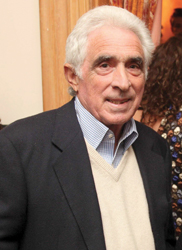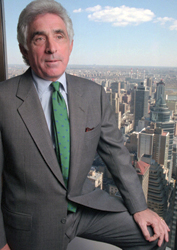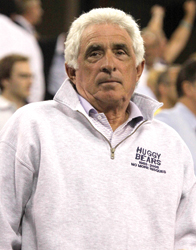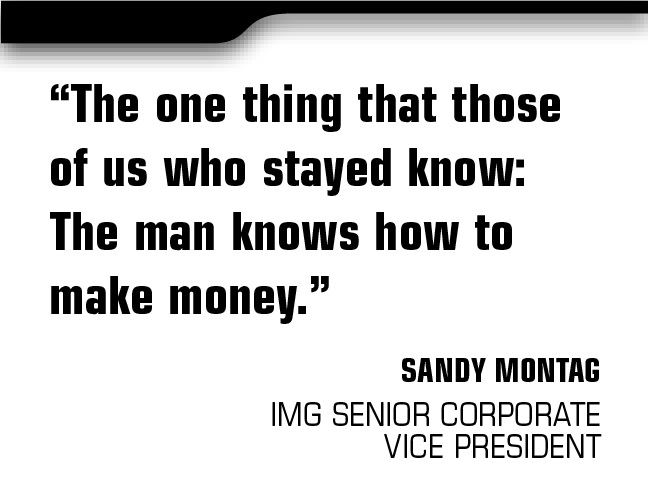For three years, Ben Sutton believed Ted Forstmann was the enemy: a leveraged buyout bogeyman who bought companies rather than building them. And Sutton swore that the one company Forstmann would never buy was his college company, ISP Sports.
 |
| Photo: NEWSCOM |
But that all changed in 2010 when Forstmann began pursuing ISP and asked Sutton to join him at Wimbledon to finalize a deal. Sutton, who brought his 14-year-old son along, spent much of his time at the legendary tennis facility captivated by the way Forstmann interacted with his two adopted South African sons, Siya, 29, and Everest, 25. They joked, poked fun at each other and Siya even threw his arm around Forstmann’s neck.
“Seeing him with his sons and the genuine respect and affection they all had for each other — they were a family,” Sutton said. “It really resonated with me. While we were there, I went up to him with my son, and said, ‘I’ve got a permission slip from this young man here. We’ve got a deal.’”
Sutton wasn’t the only one to have inconsistent perceptions of Forstmann, who died last week from brain cancer. Contradictions marked Forstmann’s life, business career and seven years at the helm of IMG.
He grew up in Greenwich, Conn., at a home with its own tennis court, baseball diamond and swimming pool, but he said his childhood was an unhappy one. He was one of the founders of the leveraged buyout industry, the ultimate insider, but he cast himself as an outsider, railing against the business in the 1980s for using junk bonds to finance takeovers.
At IMG, the company he bought for $750 million in 2004, he was out front, serving as chairman and CEO, but also reclusive, rarely making appearances at industry events. He was charming, capable of wooing reluctant sellers like Sutton and women like Elizabeth Hurley, but also shy, unable at times to captivate a room of employees. Perhaps most importantly, he was considered a villain by many former IMG employees, who believe he gutted the company, but a hero by many current IMG employees, who believe he stabilized the business with a dogged focus on profitability.
“A lot of people are misunderstood at that level because they’re complicated,” said Sandy Montag, IMG senior corporate vice president who has worked for the company for 25 years. “I saw a lot of different sides of him. He can be charming. He can be tough. He can be everything. But he was smart and always knew what he was doing. The one thing that those of us who stayed know: The man knows how to make money.”
LINKS TO OTHER STORIES:
Investors hold key to IMG future
'Whatever happens will have a trickle-down effect on every agency'
Before buying IMG, Forstmann amassed enormous wealth by using debt to buy and later flip companies for a profit. One of his most successful investments was his $850 million purchase of Gulfstream Aerospace in 1989. The company nearly filed for bankruptcy a few years later, but Forstmann took over day-to-day management and oversaw the development of a new private plane, the Gulfstream V, the first private jet capable of flying directly from New York to Tokyo. The plane sold well and the company eventually went public, generating a $2 billion return for Forstmann Little.
Forstmann had similar success flipping companies in health care (Community Health Systems), trading cards (Topps) and cable television equipment manufacturing (General Instrument). Tom Lister, a former partner at Forstmann Little, said, “His approach was to look out over a long period of time and try to figure out the value. He usually got that right.”
But his track record as an investor wasn’t perfect. In the late 1990s, he diverged from his practice of buying companies and instead invested heavily in the telecommunications industry. The companies he invested in, XO Communications and McLeodUSA, filed for bankruptcy and he lost more than $2 billion. The state of Connecticut subsequently sued him for losing $100 million invested by the state’s pension fund. Shortly thereafter, in 2004, he decided not to raise another fund from investors.
IMG was one of his last major investments. The company first caught his eye in the 1990s. He and the company’s founder, Mark McCormack, considered a joint bid to buy the Los Angeles Dodgers in 1997, and afterward he regularly talked to partners at Forstmann Little about investing in McCormack’s global sports and entertainment company. He was a sports enthusiast who played hockey at Yale, golfed regularly and considered himself a close friend of IMG client Vijay Singh.
Following McCormack’s death in 2003, Forstmann began courting the IMG founder’s family and encouraging them to sell the company to Forstmann Little. He ultimately acquired IMG for $750 million and took over as the company’s chairman. At the time, he said, “I am not a passive guy. [But] I am not going to go to Cleveland and start telling people what to do.”
Forstmann, however, insisted that IMG get its fiscal house in order. Shortly after buying the company, he convened a town hall meeting with its employees in Cleveland and insisted they focus on creating positive EBITDA (earnings before interest, taxes, depreciation and amortization).
The emphasis on profitability was new at IMG, where founder McCormack had kept the company’s finances close and pushed staff to concentrate on dominating the entire sport business. But Forstmann wanted to dominate areas that boosted the bottom line. His emphasis on EBITDA was foreign to most employees at the company.
“Someone joked that [EBITDA] was his new girlfriend,” said Rob Prazmark, an Olympic sales specialist who was at IMG and attended the Cleveland meeting. “We were a culture based on personality with Mark. Clearly, this was a business for Ted.”
■ ■ ■
In his first year of ownership, Forstmann cut IMG’s staff about 10 percent to 2,100 employees and stocked the IMG board with business and sports leaders like John Mack, former CEO of Morgan Stanley, and Dave Checketts, the former president of the New York Knicks. He also shook up the company’s management, naming former co-CEO Bob Kain president and co-CEO Alastair Johnston vice chairman. He later took over day-to-day management and named Kain a vice chairman.
 |
Forstmann, in his Manhattan office in 1996, made a career of buying and selling companies.
Photo: AP IMAGES
|
He set high standards for IMG executives and pushed them to meet his expectations. When they didn’t, the repercussions were real.
Several people recalled sitting through an IMG executive’s presentation to the company’s board that Forstmann found unrefined. After the presentation, Forstmann excused the executive and asked the board what they thought of the presentation. When the board said they didn’t like it, Forstmann agreed and told them that he planned to fire the executive in the coming days.
Those who worked for him described his management style as exacting. Arthur Shorin, the former CEO of Topps Inc., which Forstmann Little took public in 1987, said, “He had a talent for getting out of people everything they have. Like the Army, they say, ‘Be all you can be.’ Teddy has the uncanny ability to do that.”
Forstmann said 2005 was IMG’s most profitable year “by a huge margin,” but a tremendous amount of turnover followed. Peter Johnson, the president of sports and entertainment, resigned in early 2006. His departure, which was prompted in part by the change in corporate culture under Forstmann, led to a number of the top team sports agents at the company, like powerful football agent Tom Condon and baseball agent Casey Close, to exit as well.
The departures unsettled longtime IMG employees. In a letter to staff at the time, Forstmann wrote, “I know the leadership changes and concern for the ‘unknown’ can be disconcerting. Often, unfounded but disquieting rumors can get started. For example, it has been rumored that there will be significant changes in Cleveland or that it will become redundant. These kinds of rumors are totally false, very unproductive and somewhat irritating.”
George Pyne, who was brought in to replace Johnson in early 2006, initially insisted that the company was committed to the athlete representation business. He said IMG planned to fill the position vacated by Condon. But soon Pyne and executives at Forstmann Little said that when they looked at the margins on the professional sports business, they decided it didn’t make sense to stay in it.
Stick-and-ball athletes got most of their money from their team contracts, which IMG took a 3 percent share of, and generally got fewer endorsements, from which IMG took a 20 percent cut. That led Forstmann to call the acrimonious exits of team sports agents “mutual.”
“It was not a Mexican standoff,” said Montag, an IMG veteran who considered leaving at the time but stayed on to run the client representation business (except golf and tennis). “It was a conscious decision made purely because of financial interest and conflict-of-interest considerations that would exist with the academies, leagues and other areas. There were restrictions being player agents.”
■ ■ ■
Over the next year, Forstmann cast about for ways to expand IMG’s business. He hired then NHL media executive Doug Perlman in late 2006 to pioneer IMG’s digital business. But a few months later, Forstmann changed course, hiring former HBO Chief Executive Chris Albrecht to shift the company’s media focus from digital to original entertainment. But Albrecht left less than a year later, and the original entertainment strategy was abandoned.
Similarly, Forstmann hired then NBC Sports and Olympics sales chief Peter Lazarus to overhaul the company’s sales operations. Forstmann wanted Lazarus to consolidate sales efforts to create a centralized sales operation that sold sponsorships across tennis, golf and other divisions. But the effort was abandoned and Lazarus left less than a year later because each of IMG’s individual business divisions resisted the change.
 |
Forstmann’s strong move into colleges created a new base of business for IMG.
Photo: NEWSCOM |
All of these moves fed a perception that the company was having trouble finding its way under new ownership. The result was a divide between those who privately mocked IMG and those who remained staunchly loyal to Forstmann.
“His strength was also his weakness,” said Checketts, who served on the IMG board at the time. “He had incredible business insights and vision, but his approach was like his love life. He fell in and out of love with people. He’d hire them and then decide he wanted to do something else.”
Geoff McKay, a partner at Forstmann Little at the time, said, “He thinks big, and if a couple of ideas hit, that’s great.”
The most important bet Forstmann made was on the college business. In the early days of his IMG ownership, he had held discussions about college sports with Checketts, who was chairman of CSTV, the college network that CBS bought for $325 million, and saw it as an area of opportunity. After joining IMG in 2006, Pyne drafted a strategy for entering the college business that included several acquisition targets.
Forstmann signed off on a $100 million purchase of Collegiate Licensing Co., which had licensing rights for 200 schools. He then worked on a $73 million acquisition of Host Communications, which had marketing rights to schools such as Kentucky and Texas. The company bought the marketing rights to 12 more schools between 2008 and 2009 with long-term deals like the $110 million, 10-year guarantee it gave Ohio State, giving it the largest annual guarantee of any school at the time.
WHAT OTHERS
ARE SAYING
----------------------------
“Ted Forstmann had a vision for IMG. He changed the company from its core, in terms of its business focus and its culture. Both the old IMG was and the new IMG is highly influential in the industry, but in very different ways.”
Phil de Picciotto
President, Octagon
“Ted was a really big-picture guy. He was a gambler. He was an instinctive risk-taker and backed his hunches and backed the people that brought them to him who he trusted. … He believed it was much better to own things and invent things than to collect fees from it.”
Ian Todd
Former president,
IMG International
“He said he didn’t want to be the CEO, and I never believed him. He actually embraced it and didn’t want to give it up.”
Dave Checketts
Former IMG board member
“He wanted to go after high growth and scalable businesses and also add more management best practices from other industries that he had had the opportunity to see in other ventures. He explained to me that even though the agent business is a great business, it’s not scalable. If you have 10 clients and want to double, you have to have 20 clients. It’s linear growth, as he would say.”
Robert Birge
Former IMG chief marketing officer
“Ted knew the [McCormack] family and a little about the business. He thought it was interesting because it was a great brand. There aren’t many brands of that caliber globally, and that was a tribute to Mark [McCormack], and Ted thought it could go to a different level considering how the world was becoming more globalized.”
Geoff McKay
Former partner at
Forstmann Little
“Ted was a visionary who had a plan. An owner who wanted to be an operator. … Like a great businessman, he went a million miles an hour and had great thoughts and ideas and sometimes wanted to move quicker than the marketplace would let him.”
Peter Lazarus
Senior vice president,
head of multimedia sales
at USA Today Sports Media Group
“Has everything worked? No, but you can’t move forward if you’re afraid of mistake and failure. Have we made investments that haven’t worked out? Sure. But if you look at what works and what hasn’t worked, the results speak for themselves in terms of growth and achievement. At the end of the day, what’s the scoreboard say? I think it will say that there’s been financial and strategic success.”
George Pyne
President, IMG Sports and Entertainment
— Compiled by Tripp Mickle
But Forstmann wasn’t done. He believed he needed to buy ISP, which had marketing rights at Florida State, Georgia, UCLA, Duke and dozens of other schools, to complete his vision for consolidating the fragmented college business and turn IMG College into a one-stop shop for sponsors looking to associate with schools.
Sutton, who founded ISP in 1992, resisted Forstmann’s overtures at first, but Forstmann ultimately won him over at Wimbledon. The resulting $100 million deal for ISP nearly tripled the number of schools under IMG’s control.
“He understood that if you combined all these businesses together — Alabama and Auburn, Florida State and Texas — all the boats would rise together, and he put the bull’s-eye squarely on the National Football League and Major League Baseball,” Sutton said.
While critics have charged that IMG overpaid for college assets and will never fulfill its financial guarantees to colleges,the deals have been the backbone of IMG’s recent growth. According to people who have seen the company’s books, the college business will be half of the company’s earnings this year, when IMG’s overall EBITDA is set to hit $140 million, and more than 70 percent of the growth in earnings in future years. Those numbers could not be independently verified.
“He hit a home run with his investment in IMG College,” said Barry Frank, a longtime IMG executive. “That’s going to become one of the bases of the company in the years to come. He saw the opportunity and pounced on it.”
■ ■ ■
Forstmann also looked to expand IMG’s sports operations overseas. The company had a strong history internationally and had 65 offices in 30 countries worldwide. He focused on emerging markets and led negotiations that resulted in joint ventures in China with CCTV; India with Reliance Industries, which is owned by India’s richest man, Mukesh Ambani; and Brazil with EBX Group, a conglomerate founded by one of Brazil’s richest men, Eike Batista.
Most of those partnerships are still too nascent to show tangible results, but during Forstmann’s ownership, IMG played an instrumental role in creating the Indian Premier League. In just four years, the IPL sold a franchise for $370 million and has seen the consultancy Brand Finance value the league at $4.13 billion. IMG didn’t receive a stake in the league but does get annual management fees from it.
“He said ‘We have this expertise and knowledge and 30 years ago we took it to Japan and Australia and Germany. Now it’s time to take it to these emerging countries, a China, an India, a Brazil,’” said Ian Todd, senior consultant and adviser to the chairman of the board at IMG. “He was very smart in pursuing these international ventures, which are still in their infancy, but in five or 10 years time could bear some fruit.”
Sales rumors constantly swirled around IMG during Forstmann’s ownership. In 2007, Goldman Sachs reportedly valued the company at more than $1.5 billion, twice what Forstmann paid for it. But an IMG spokesman adamantly denied the valuation and insisted there were no plans to sell the company.
The company’s executives forcefully maintained, even after Forstmann was diagnosed with brain cancer in May, that there were no plans to sell IMG. But Forstmann told The New York Times in July 2011 that his diagnosis had added urgency to his efforts to “build” IMG, saying, “I want to make a bunch of money now, stick it in a charitable trust and give it away.”
Forstmann’s ownership of IMG wasn’t without its headaches. In late 2010, he was sued by a former golfing partner, James Agate, who accused Forstmann of betting on college sports and a tennis match featuring IMG clients Rafael Nadel and Roger Federer. He dismissed the accusations as false and little came of them, but his public reputation was sullied by the charges.
Forstmann also struggled with strained ties with former IMG employees. In 2011, after USA Today wrote a sports section cover story that said Forstmann “transformed IMG into a global sports, fashion and media empire,” Kain, the former IMG co-president, wrote a letter to the editor explaining IMG’s history in the sports and entertainment business.
“IMG had long been the global leader in those arenas (approximately 2,500 employees in more than 65 offices in 30 countries) before Forstmann acquired it,” Kain wrote. He added, “Most alumni are cheering for IMG’s continued success. But we are motivated to honor the vision of McCormack and the accomplishments of his loyalists. IMG’s history should be enhanced by the company’s current operations. It shouldn’t be rewritten.”
When Forstmann told The New York Times four months later that he overpaid for the company and called it a “piece of shit,” one former IMG employee, Michael Wright, wrote a letter to SportsBusiness Journal challenging Forstmann’s claim.
“Ted continually talks about how profitable he has made IMG, a company he says was ‘barely break-even’ when he bought it,” Wright wrote. “There has never been any type of audited statement to prove this newfound profitability. And if the company is so profitable now, why are there no suitors lining up to purchase it?”
Forstmann claimed last year that he had turned away IMG suitors. He told Vanity Fair that former Yahoo! CEO Terry Semel approached him about buying the company, but that he wasn’t ready to sell. He wanted to continue to improve the company’s EBITDA and raise its value before it was sold.
When IMG is sold, it will look considerably different than it did when Forstmann acquired it in 2004. His imprint will be visible in the company’s focus on profitability and its new business areas.
Few employees dealt with Forstmann directly. He limited his interaction to division heads of stand-alone business units, men like Montag, who ran the client representation business, and Mark Steinberg, who ran IMG’s golf business before leaving the company earlier this year. The rest of the staff of more than 2,500 employees rarely saw him.
“He doesn’t meddle,” Sutton said. “He was always thinking about the next big idea, not the granular details.”
When he wasn’t working on Forstmann Little or IMG, Forstmann focused on his philanthropic work. Though he never had children of his own, he directed most of his philanthropic efforts to children’s causes. He co-founded Children’s Scholarship Fund, a charity that provides underprivileged students with scholarships to private schools, and was the only non-African trustee of the Nelson Mandela Children’s Fund, which provides financial support and opportunities to street children.
When asked last May by The New York Times why he focused so much of his work on children, Forstmann said, “They’re helpless.”
Even though the last fund he raised at Forstmann Little expired in 2006, Forstmann never considered retiring. He told Leaders magazine that he couldn’t slow down because he had a disease that he called “the moving goalpost disease.”
“For instance, I founded the Children’s Scholarship Fund after funding a small program for 800 kids in the Washington area,” Forstmann said. “It was great, and I asked why it couldn’t work all across the country. Two years later, we had the Children’s Scholarship Fund. So far, we have sent 92,000 poor kids to school, and we have partners all over the country. So you don’t know what you can do until you do it.”
Staff writer Michael Smith contributed to this report.








